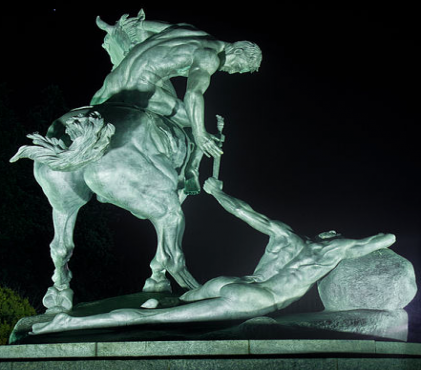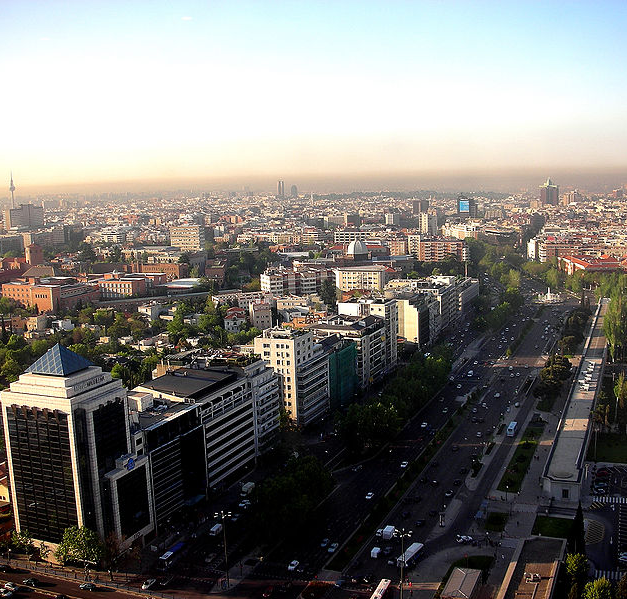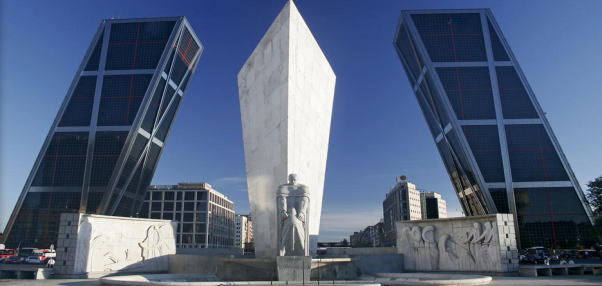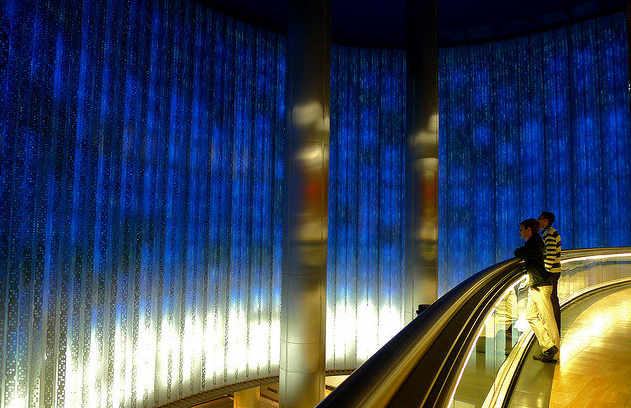MADRID
CENTER
SOUTH
NORTH
Back to up
Ciudad Universitaria
The University City of Madrid ( Spain ) , also known as Campus Moncloa is located in the district of Moncloa -Aravaca , in the northwest of the city . There most of the faculties and colleges of the Complutense University of Madrid and the Polytechnic University of Madrid is located, as well as more than thirty colleges and facilities of the National University of Distance Education . In this area there are marked college environment , in addition to the powers and rectories , many student residences , major colleges, three gymnasiums, swimming pools, botanical gardens and extensive parkland. Officially, the boundaries of University City neighborhood are: the north, Avenue of the Enlightenment and the wall of the Monte de El Pardo , to the east , the New Zealand streets , Isla de Oza , Antonio Machado, Francos Rodríguez , Numancia , Doctor Federico Rubio y Gali, and Avenida Pablo Iglesias ; to the south , Avenida Reina Victoria, Moncloa Avenue , Paseo Juan XXIII , Isaac Peral Street , Arco de la Victoria Avenue , Seneca Avenue and the Highway of Castilla ; and west , fences Zarzuela Racecourse and the wall of the Casa de Campo.

El Arco de la Victoria de Madrid ( popularly known as Puerta de la Moncloa to have some similarity with the Doors Alcala and Toledo and Triumphal Arch ) is a triumphal arch built between the period from 1950 to 1956. initial indication is constructed by the Standing Committee of the Board of Universitaria.1 City is an urban work commemorating the victory of the rebel army in the war suffered during the Spanish Civil War at the Battle of Ciudad Universitaria. March 2 Arch is located in one of the main entrances of Madrid ( the road from La Coruña) , in the center of the so-called Avenida del Arco de la Victoria district of Moncloa- Aravaca. The arch has a height of almost 40 meters. It is the work of architect Modesto López Otero Pascual Bravo Sanfeliú , and ornaments surrounding the Moses Huerta ( allegorical friezes ) , Ramón Arregui ( Chariot of Minerva) and José Ortells sculptors. The Arc has a Latin inscriptions recalling the victory and the construction of the new University City after the armed conflict that destruyó.
Moncloa
Castellana
Paseo de la Castellana (English: The Castilian's Mall), commonly known as La Castellana, is one of the longest and widest avenues of Madrid. It is named after an old fountain that used to exist in Plaza de Castilla. It starts at Plaza de Colón, passes through the Nuevos Ministerios, Plaza de Lima, Plaza de Cuzco, Plaza de Castilla, and ends near the Nudo Norte (North Junction), connecting with the M-30 and the road to Colmenar Viejo. The Paseo de la Castellana is the continuation of Paseo de Recoletos and Paseo del Prado, and these three avenues vertebrate the north-south axis of the city.
As part of an ambitious project called Operación Chamartín, it is planned to extend it further to the north, where a big number of railway lines will be dug underground and the area will be transformed with high-rise buildings. This project was recently brought to life again, after many years of debate.
To the west of La Castellana lie the districts of Chamberí and Tetuán, and to the east, the districts of Salamanca and Chamartín.
Many business, banking and financial buildings are located along La Castellana or its immediate proximity, including those that house AZCA, Puerta de Europa, and the CTBA. Also, many of the most important embassies are located in or around the stretch between Plaza de Colón and Plaza del Doctor Marañón. Other landmarks that can be found along this street are the Nuevos Ministerios complex, where the offices of several ministries of the Spanish Government are located, and the Santiago Bernabéu Stadium.
Between 1952 and 1981, the stretch north of Nuevos Ministerios was called Avenida del Generalísimo.


Torres Kio
The Gate of Europe towers (Spanish: Puerta de Europa), also known as KIO Towers (Torres KIO), are twin office buildings in Madrid, Spain. The towers have a height of 114 m (374 ft) and have 26 floors. They were constructed from 1989 to 1996. The Puerta de Europa is the second tallest twin towers in Spain after the Torres de Santa Cruz in Santa Cruz de Tenerife.
Madrid Chamartín is the name of the second major railway station in Madrid, Spain. Positioned on the north side of the city, it was built prior to the time of the 1982 FIFA World Cup, between 1970 and 1975, although subsequent work would be carried on into the early 1980s. At that time it superseded Atocha station, located closer to the city centre. After Atocha itself was rebuilt in 1992, Chamartin lost much of its importance, even though since 2004 it has undergone changes to accommodate the new high-speed line to Valladolid.
It hosts the railway networks connecting Madrid and north-western Spain, the AVE (high speed line) from Madrid to Segovia and Valladolid, and some Cercanías lines (commuter rail), plus the international line to Lisbon. There are also connections with Atocha. Under the railway station there is a Metro Station (Chamartin) linking with lines 1 and 10 of the Madrid Metro, for travelling to Madrid city centre.
Estacion de Chamartin

The population of Madrid at the beginning of the 19th century was about 220.000, increasing to 300.000 inhabitants in the late 1850s. However, the city was still enclosed within the defensive wall built in 1625 by king Philip IV of Spain, which blocked the city growth. In 1857, government allowed the then Minister of Public Works and Transportation Claudio Moyano to expand the city (Plan Castro). Queen Isabella II allowed so in 1860 and the defensive walls were torn down in order to build the first Madrilian ensanche. Don José de Salamanca y Mayol, Marquis of Salamanca, gave his name to the area because of his involvement in the project. It was completely urbanized by 1927.
Since then, the Salamanca district has been one of the most representative areas for bourgeois madrileños. Salamanca is in the outer area of the "Rondas", where the neighborhoods of Guindalera and Fuente del Berro originated with more spontaneous urban development. Marqués de Salamanca Square separates the wealthy area from the more popular parts of the district. Nowadays, the Salamanca district is one of the wealthiest areas in Madrid and some of its streets, such as Goya or Serrano are part of the most expensive streets in Spain.
Salamanca
The Plaza de Toros de Las Ventas is a famous bullring in Madrid (Spain).
Situated in the Guindalera quarter of the district of Salamanca, it was inaugurated on June 17, 1931. It has a seating capacity of 25,000 and is regarded as the home of bullfighting in Spain.[citation needed]
This bullring was designed by the architect José Espeliú in the Neo-Mudéjar (Moorish) style with ceramic incrustations. The seats are situated in ten "tendidos". The price of the seats depends upon how close they are to the arena and whether they are in the sun or the shade (the latter being more expensive). The bullfighting season starts in March and ends in October; bullfights are held every day during the San Isidro Fiesta, and every Sunday or holiday during the season. Bullfights start at 6 or 7pm and last for two to three hours.
Ventas

Adolfo Suárez, Madrid-Barajas Airport is Madrid's biggest airport. It is in the district of Barajas, northeast of the centre of Madrid. On March 24, 2014, the Spanish government announced that they will rename the airport after last Prime Minister of Spain Adolfo Suarez.
The airport was originally set up in 1931. At first it was only a small building. The first terminal, now known as Terminal 2, was built in 1952. Air traffic increased. Because of this the airport was again expanded in 1971. Terminal 1 was made. It was meant for international traffic. In 1997, Terminal 3, then known as Terminal Norte opened. It was mainly for the Air Shuttle service between Madrid and Barcelona. Terminal 4 was opened, together with its satellite terminal, in February 2006.
The airport has four terminal buildings and a satellite terminal: T1, T2, T3, T4 and T4S. The three first are connected. T4 can be reached with a free shuttle bus. The satellite terminal is reachable from the T4 by an underground automatic train.
Adolfo Suárez Madrid-Barajas Airport